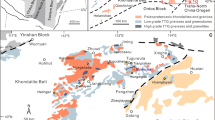Abstract
Kelyphite is a reaction product between garnet and olivine, which was formed by subsolidus reactions upon decompression during the ascent of mantle peridotite. We studied crystallographic relationships among constituent (product) phases of kelyphite – orthopyroxene, clinopyroxene, spinel and reactant phases, garnet and olivine, using EBSD and found that, for a relatively high temperature sample (from Czech Moldanubian), spinel and pyroxenes are in a topotaxic relationship in such a way that spinel {111} coincides with pyroxene (100) and spinel {110} coincides with pyroxene (010); while the topotaxy is incomplete or non for a lower-temperature sample (from western Norway). On the basis of the observed microstructural and crystallographic relationships, we propose a hypothesis that the topotaxic relationship may be established at nucleation stages of the onset of the kelyphitization and that the degree of topotaxy may be related to the transformation temperature and the degree of supersaturation of the reaction. The lower the temperature, the higher the supersaturation and, therefore, more rapid the nucleation becomes, resulting in a more disordered state in topotaxic relationship.






Similar content being viewed by others
References
Cameron M, Papike JJ (1980) Crystal chemistry of silicate pyroxenes. In: Prewitt CT (ed) Pyroxene, reviews in mineralogy, 7. Mineralogical Society of America, Washington, pp 5–92
Carswell T (1986) The metamorphic evolution of Mg-Cr type Norwgian garnet peridotites. Lithos 19:279–297
Degi J, Abart R, Kalman T, Bali E, Wirth R, Rhede D (2009) Symplectite formation during decompression induced garnet breakdown in lower crustal mafic granulite xenoliths: mechanisms and rates. Contrib Minerl Petrol 159:293–314
Grunter JW (1929) Structural reasons for oriented intergrowth in some minerals. Am Mineralog 14:227–237
Kamei A, Obata M, Michibayashi K, Svojtka M, Hirajima T (2010) Two contrasting fabric patterns of olivine observed in garnet and spinel peridotite from a mantle-rerived ultramafic mass enclosed in falsic granulite, the Moldanubian Zone, Czech Republic. J Petrol 51:101–123
Kushiro I, Yoder HS Jr (1966) Anorthite-forsterite and anorthite-enstatite reactions and their bearing on the basalt eclogite transformation. J Petrol 7:337–362
Medaris LG, Wang HF, Misar Z, Jelineck E (1990) Thermobarometry, diffusion modelling and cooling rates of crustal garnet peridotites: two examples from teh Moldanubian zone of the Bohemian Massif. Lithos 25:189–202
Odashima N, Morishita T, Ozawa K, Nagahara H, Tsuchiyama A, Nagashima R (2008) Formation and deformation mechanisms of pyroxene-spinel symplectite in an ascending mantle, the Horoman peridotite complex, Japan: an EBSD (electron backscatter diffraction) study. J Mineral Petrol Sci 103:1–15
Ozawa K (2004) Themal history of the Horoman peridotite complex: a record of thermal perturbation in the lithosphereic mantle. J Petrol 45:253–273
Ozawa K, Takahashi N (1995) P-T history of a mantle diapir: the Horoman peridotite complex, Hokkaido, northern Japan. Contrib Mineral Petrol 45:253–273
Putnis A (1992) Introduction to mineralogical sciences. Cambridge Univ. Press, Cambridge
Spengler D, van Roermund HLM, Drury MR, Ottolini L, Mason PRD, Davies GR (2006) Deep origin and hot melting of an Archaean orogenic peridotite massif in Norway. Nature 440:913–917
Spengler D, Brueckner HK, van Roermund HLM, Drury MR, Mason PRD (2009) Long-lived, cold burial of Baltica to 200 km depth. Earth Planet Sci Lett 281:27–35
Taylor WR (1998) An experimental test of some geothermometer and barometer formulation for upper mantle peridotites with application to the thermobarometry of fertile lherzolite and garnet websterite. Neues Jb Mineralog Abh 172:381–408
Acknowledgement
We thank Dirk Spengler for providing sample of Norway and JSPS for their support for Japan-Czech collaborative project (Grant-in Aid No. 14403013 to T. Hirajima) , which made sampling the Czech peridotite possible. We also thank H. Nagahara (Univ. Tokyo) for her permission of the use of FE-SEM and EBSD at Univ. Tokyo and H. Yoshida for his technical assistance, and to T. Morishita and R. Nagashima (both Kanazawa Univ.) for their discussions. We are grateful to Dr. A. Putnis for his instruction of a correct usage of ‘topotaxic relationship’. The paper was benefitted by constructive critisisms of Drs. R. Abart and N. Timms, to whom we are grateful.
Author information
Authors and Affiliations
Corresponding author
Additional information
Editorial handling: R. Abart
Rights and permissions
About this article
Cite this article
Obata, M., Ozawa, K. Topotaxic relationships between spinel and pyroxene in kelyphite after garnet in mantle-derived peridotites and their implications to reaction mechanism and kinetics. Miner Petrol 101, 217–224 (2011). https://doi.org/10.1007/s00710-011-0145-y
Received:
Accepted:
Published:
Issue Date:
DOI: https://doi.org/10.1007/s00710-011-0145-y




